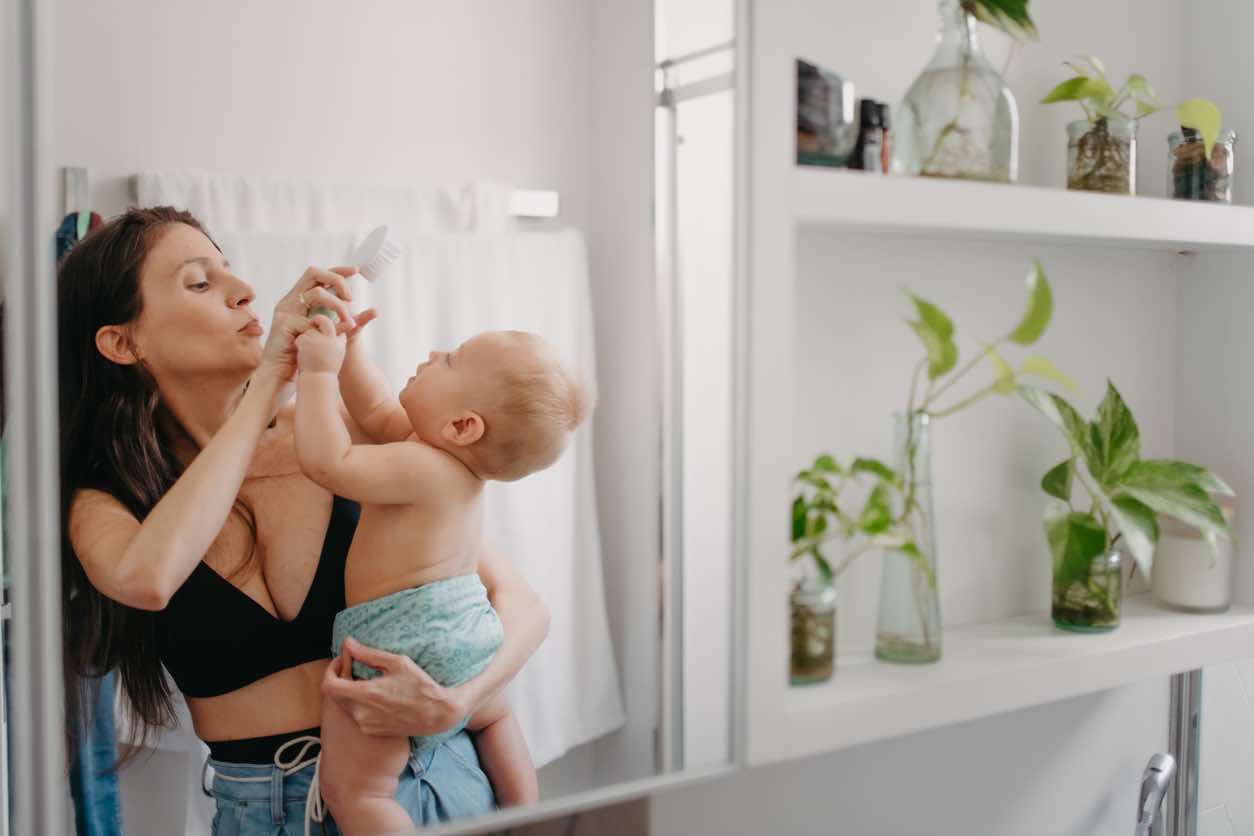How to Fix Postpartum Urinary Incontinence and Pelvic Floor Issues

During pregnancy and postpartum, a woman’s body goes through a myriad of changes. It doesn’t just magically “bounce back” to what it looked like before baby unlike what Hollywood often portrays.
Postpartum urinary incontinence is a medical condition where an individual is unable to control their bladder and experiences involuntary urine leakage. Many women struggle with this after giving birth.
We spoke with Kim Vopni, a self-professed Kegel maven who is known as The Vagina Coach. She is a certified fitness professional who became passionate about spreading information on pelvic health after the birth of her first child over 18 years ago.
Related: The Ultimate Guide to Postpartum Care (From Underwear to Hair Loss)
Kim is an author, a passionate speaker, and a women’s health educator. Her most recent book, Your Pelvic Floor, launched in March 2020 and was on the bestseller list immediately.
Our pelvic floor experts explain what postpartum urinary incontinence is, how common it is, its causes, treatments, and tips to prevent, fix and minimize symptoms.
How Common Is Postpartum Urinary Incontinence?
About one-third of women have urinary incontinence and up to one-tenth have fecal incontinence after childbirth. Those who had bladder control issues during pregnancy are three times more likely to experience incontinence after childbirth.
How Long Does Urinary Incontinence Last?
Many moms and pregnant women joke about peeing their pants when they laugh, sneeze, jump, move or cough. They may believe that it’s just part of daily life and they bear the cost of having children.
Although bladder leakage is common, urinary incontinence is not something we should joke about as it can negatively impact your quality of life.
“If left untreated it does not typically resolve but rather continues to worsen over the years,” says Vopni.
Causes of Postpartum Urinary Incontinence

There are several causes for postpartum urinary incontinence including genetics, type of delivery and lifestyle factors.
For instance, women who undergo a cesarean section are less likely to experience bladder control issues than those who deliver vaginally. Those who experienced a forceps or vacuum delivery also are at an increased risk.
Other factors that may contribute to a risk of postpartum urinary incontinence include being overweight, having multiple births (twins, triplets, etc.), experiencing bladder control issues and urine leakage during pregnancy and having given birth before.
Pelvic Floor Dysfunction
Vopni explained how pelvic floor disorders can be developed during pregnancy and birth and they can contribute to postpartum urinary incontinence.
“We have muscles in our pelvis called the pelvic floor and one of their jobs is to manage the openings of the urethra, vagina and anus. The muscles help control the sphincters that help close the urethra to prevent urine from leaking out.
The pelvic floor muscles need to react at the right time with the right amount of force to close the openings. Various things, like pregnancy and birth, can interfere with the reaction time of the pelvic floor as well as hinder force production.”
Hormone Changes
Changes in hormone levels also play a role in contributing to urinary incontinence.
“After giving birth there is a steep drop in estrogen. The tissues in the vagina and around the bladder love estrogen and when there isn’t as much circulating, the tissues can become drier and thinner and less robust,” says Vopni.
Back Pain
“Another factor is back pain. Back pain is very common in pregnancy and back pain is very closely tied to pelvic floor dysfunction,” says Vopni.
A study looked at the association between low back pain, and stress urinary incontinence postpartum. It showed that stress incontinence was associated with older age, primiparity, vaginal delivery, and low back pain at 3 months postpartum.
The researchers concluded that it would be beneficial to include pelvic floor muscle training can be an effective treatment for stress urinary incontinence. Although it is very common to experience urine leakage after birth, it’s important to know that you don’t have to have been pregnant or have given birth to experience this.
According to Vopni, “Approximately 30% of women experience stress urinary incontinence which is leaking urine with things like laughing, coughing, sneezing, and exercise.”
A cross-sectional study looked at non-pregnant women who were experiencing lumbopelvic pain.
The study showed that:
- Over 95% of women with low back pain have some form of pelvic floor dysfunction
- 71% of the participants experienced pelvic floor muscle tenderness
- 66% had pelvic floor weakness.
- Over 40% had pelvic organ prolapse where one or more of the organs (vagina, uterus, bladder and rectum) shift down from their normal position and sag outside of the body.
Urinary Incontinence Treatments (Non-Surgical and Surgical)
Do not be afraid to bring up your concerns about urinary incontinence with your healthcare provider. It is not something you have to live with or a part of being a mother.
The good news is that this is a totally treatable condition.
Choosing an effective intervention depends on the severity of the condition, the specific cause and how much it impacts your daily functioning.
There are multiple treatment options available for those suffering from urinary incontinence:
Pelvic Floor Physical Therapy

Pelvic floor physical therapy is always the recommended first line of defence. Pelvic floor exercises, also known as Kegel exercises can help strengthen the muscles that support the bladder, urethra, anus and rectum and improve symptoms.
Vopni advises, “It is important to learn how to do Kegels correctly and to learn to incorporate them into whole-body exercises and activities of daily living.”
For those who do have access to a pelvic physiotherapist, electric stimulating devices such as Yarlap or Kegel8 can be helpful. These devices send electrical impulses to stimulate the pelvic muscles to contract similar to performing kegel exercises naturally.
Surgery
There are surgical options to help reduce urine leakage and improve pelvic floor function; however, these are offered when all other options have not worked.
“Some believe that surgery is the only option and may be offered that as a solution. Surgery may be chosen or needed by some but there are many conservative options to pursue first. It is also important to note that even if surgery is chosen or needed, pelvic floor exercise remains essential for life,” explains Vopni.
Lifestyle Tips To Prevent Or Fix Urinary Incontinence
For those who are currently pregnant or experiencing urinary incontinence, there are several lifestyle changes you can make to help decrease the risk of developing postpartum incontinence:
See a Pelvic Floor Physical Therapist
One of the best ways to protect your pelvic floor and prevent incontinence is to learn from a professional. They can teach you how to do specific exercises to strengthen your pelvic muscles.
“I highly recommend that pregnant women see a pelvic floor physio during pregnancy and pre-book a postpartum visit for 8 weeks postpartum,” advises Vopni.
Diet Changes
There are several diet changes that you can make to help reduce the risk of urine leakage.
- Limit your caffeine. Caffeinated drinks such as coffee, tea, and soda are diuretics and consuming caffeine has been shown to increase the frequency of urination.
- Consume a fiber-rich diet to prevent constipation. Straining during bowel movements can put additional stress on the pelvic floor muscles and cause bladder control issues. Good sources of fibre include vegetables, fruits, whole grains, beans, legumes and nuts.
- Limit the number of fluids you drink at night. Drinking lots of water or other fluids close to bedtime will help limit the number of times you’re waking up to use the bathroom in the middle of the night.
Keep A Healthy Body Weight
Carrying extra weight can add pressure on the bladder and weaken the pelvic floor muscles and ligaments.
Stay Active
Exercising regularly and strengthening the core muscles throughout life can help women protect their pelvic floor muscles and minimize their risk of developing urinary incontinence.
Vopni explains. “I recommend women stay active during pregnancy and pay attention to the posture changes that happen. Pelvic floor exercise is essential in pregnancy and for life.”
The book Pregnancy Fitness is a great resource for pregnancy.
It’s important to avoid high-impact exercises during pregnancy as it can put additional pressure on the pelvic floor. Be sure to ask a healthcare professional who specializes in prenatal exercise to show you the proper technique and appropriate ways to strengthen your core.
For more exercises to try in your postpartum exercise program, see Family Education’s round-up of The Best Postpartum Workouts for New Moms.
...
About the Expert
Kim Vopni offers pelvic health programs and coaching for women and is also a menopause support practitioner. Her Buff Muff app is an ever-growing community where people from around the world find support through her 28-day challenges and monthly membership.
Kim also certifies other fitness and movement professionals to work with women with core and pelvic floor challenges through her Core Confidence Specialist Certification and Pre/Postnatal Fitness Specialist Certification.
You can find her online through her podcast Between Two Lips and on social media @vaginacoach.

